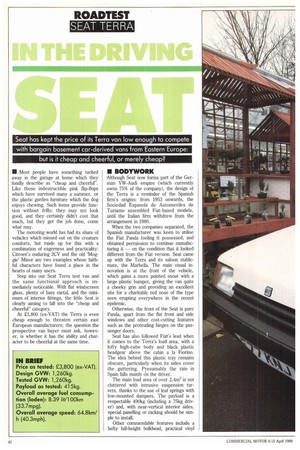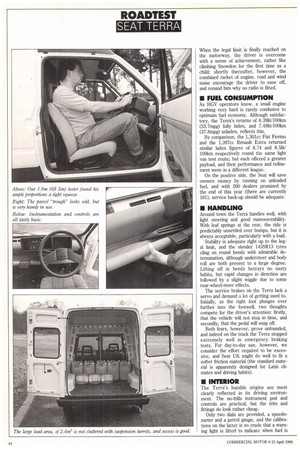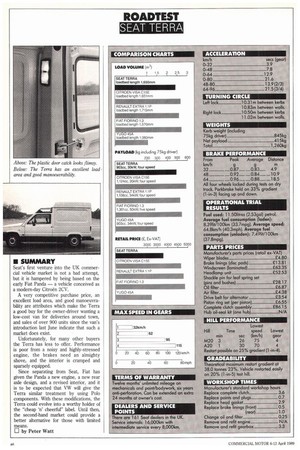Seat has kept the price of its Terra van low
Page 44

Page 45

Page 46

Page 47

Page 48

If you've noticed an error in this article please click here to report it so we can fix it.
enough to compete with bargain basement car-derived vans from Eastern Europe: but is it cheap and cheerful, or merely cheap?
• Most people have something tucked away in the garage at home which they fondly describe as "cheap and cheerful". Like those indestructible pink flip-flops which have survived many a summer, or the plastic garden furniture which the dog enjoys chewing. Such items provide function without frills: they may not look good, and they certainly didn't cost that much, but they get the job done, come what may.
The motoring world has had its share of vehicles which missed out on the creature comforts, but made up for this with a combination of eagerness and practicality: Citroen's enduring 2CV and the old 'Moggie' Minor are two examples whose faithful characters have found a place in the hearts of many users.
Step into our Seat Terra test van and the same functional approach is immediately noticeable. With flat windscreen glass, plenty of bare metal, and the minimum of interior fittings, the little Seat is clearly aiming to fall into the "cheap and cheerful" category.
At 0,800 (ex-VAT) the Terra is even cheap enough to threaten certain east European manufacturers; the question the prospective van buyer must ask, however, is whether it has the ability and character to be cheerful at the same time.
• BODYWORK
Although Seat now forms part of the German VW-Audi empire (which currently owns 75% of the company), the design of the Terra is a reminder of the Spanish firm's origins: from 1953 onwards, the Sociedad Espanola de Automoviles de Turismo assembled Fiat-based models, until the Italian firm withdrew from the arrangement in 1980.
When the two companies separated, the Spanish manufacturer was keen to utilise the Fiat Panda tooling it possessed, and obtained permission to continue manufacturing it — on the condition that it looked different from the Fiat version. Seat came up with the Terra and its saloon stablemate, the Marbella. The main visual innovation is at the front of the vehicle, which gains a more pointed snout with a large plastic bumper, giving the van quite a cheeky grin and providing an excellent site for a charitable red nose of the type seen erupting everywhere in the recent epidemic.
Otherwise, the front of the Seat is pure Panda, apart from the flat front and side windows and other cost-cutting features such as the protruding hinges on the passenger doors.
Seat has also followed Fiat's lead when it comes to the Terra's load area, with a lofty high-cube body and black plastic headgear above the cabin a la Fiorino. The idea behind this plastic tray remains obscure, particularly when its sides cover the guttering. Presumably the rain in Spain falls mainly on the driver.
The main load area of over 2.4m3 is not cluttered with intrusive suspension turrets, thanks to the use of leaf springs with low-mounted dampers. The payload is a respectable 490kg (including a 75kg driver) and, with near-vertical interior sides, special panelling or racking should be simple to install.
Other commendable features include a hefty full-height bulkhead, practical vinyl floor covering, a low loading lip, and 180°opening doors giving unimpeded access to the load area. Black marks are for the seemingly flimsy plastic catches to hold the doors back, an interior light which doesn't switch on when the doors are opened and the absence of tie-down eyes.
• DRIVELINE
The Fiat heritage is also reflected in the Seat driveline: the Terra drives its front wheels with the old 903cm3 four-cylinder overhead valve engine and four-speed gearbox used in the 127.
Seat has, however, attempted to bring the engine up to date with a host of minor modifications designed to reduce noise and boost efficiency. Significantly, it has also tuned the engine to run on unleaded or two-star fuel without modification.
With a single-choke carburettor and a lowish 8.5:1 compression ratio, the transversely-mounted power unit produ ces a modest 3 OkW (40hp) at 5,400rpm, with 60Nm (441bft) of torque at 3,00Orpm.
• PERFORMANCE
Put an ageing 30kW engine in a van with a hefty near 500kg pay load and the aerodynamics of a terraced house, and one result could a disgruntled delivery driver.
Even tricks of the trade like slipstreaming double-decker buses and out-braking dispatch riders will not leave the pack behind for long.
The Terra is underpowered. Low gearing makes the most of what is available, and the gutsy little engine seems to thrive on being made to make noises that engines shouldn't, but once you have worked out that the noise is not synonymous with speed, you tend to become frustrated with the lack of forward progress.
The Terra is most unhappy out of town, where the lack of pull at A-road speeds is sometimes an embarrassment. When the legal limit is finally reached on the motorway, the driver is overcome with a sense of achievement, rather like climbing Snowdon for the first time as a child; shortly thereafter, however, the combined racket of engine, road and wind noise encourage the driver to ease off, and remind him why no radio is fitted.
• FUEL CONSUMPTION
As HGV operators know, a small engine working very hard is rarely condusive to optimum fuel economy. Although satisfactory, the Terra's returns of 8.391it/100km (33.7mpg) fully laden, and 7.491it/1001un (37.8mpg) unladen, reflects this.
By comparison, the 1,301cc Fiat Fiorillo and the 1,397cc Renault Extra returned similar laden figures of 8.74 and 8.5lit/ 100km respectively round the same light van test route; but each offered a greater payload, and their performance and refinement were in a different league.
On the positive side, the Seat will save owners money by running on unleaded fuel, and with 200 dealers promised by the end of this year (there are currently 161), service back-up should be adequate.
• HANDLING
Around town the Terra handles well, with light steering and good manoeuvrability. With leaf springs at the rear, the ride is predictably unsettled over bumps, but it is always acceptable, particularly with a load.
Stability is adequate right up to the legal limit, and the slender 145SR13 tyres cling on round bends with admirable determination, although understeer and body roll are both present to a large degree. Lifting off in bends betrays no nasty habits, but rapid changes in direction are followed by a slight wiggle due to some rear-wheel-steer effects.
The service brakes on the Terra lack a servo and demand a lot of getting used to. Initially, as the right foot plunges ever further into the footwell, two thoughts compete for the driver's attention: firstly, that the vehicle will not stop in time, and secondly, that the pedal will snap off.
Both fears, however, prove unfounded, and indeed on the track the Terra stopped extremely well in emergency braking tests. For day-to-day use, however, we consider the effort required to be excessive, and Seat UK might do well to fit a softer friction material (the standard material is apparently designed for Latin climates and driving habits).
• INTERIOR
The Terra's humble origins are most clearly reflected in its driving environment. The no-frills instrument pod and controls are practical, but the trim and fittings do look rather cheap.
Only two dials are provided, a speedometer and a petrol gauge, and the calibrations on the latter is so crude that a warning light is fitted to indicate when fuel is low! Most minor controls are on the pod to the left of the instruments, where they are easy to confuse, particularly at night (no illumination is fitted).
Regulating the heating and ventilation is difficult and not helped by a fan with only one (noisy) speed. Interior storage space is largely confined to a large padded PVC trough running across the front of the cabin, but this is no hardship since it swallows all manner of clobber with ease. Visibility is satisfactory to the front and rear, with the lack of a rear wiper compensated for by excellent door mirrors.
A final comment on the interior is that large drivers will find life very cramped. As the head restraint provides unexpected support to the shoulder blades, and your knees operate the controls on the steering column, you are put in mind of how Gulliver must have felt, awakening in a world designed for smaller people.
• SUMMARY
Seat's first venture into the UK commercial vehicle market is not a bad attempt, but it is hampered by being based on the early Fiat Panda a vehicle conceived as a modern-day Citroen 2CV.
A very competitive purchase price, an excellent load area, and good manoeuvra bility are attributes which make the Terra a good buy for the owner-driver wanting a low-cost van for deliveries around town, and sales of over 900 units since the van's introduction last June indicate that such a market does exist.
Unfortunately, for many other buyers the Terra has less to offer. Performance
is poor from a noisy and highly-stressed engine, the brakes need an almighty shove, and the interior is cramped and sparsely equipped.
Since separating from Seat, Fiat has given the Panda a new engine, a new rear axle design, and a revised interior, and it is to be expected that VW will give the Terra similar treatment by using Polo components. With these modifications, the Terra could evolve into a worthy holder of the "cheap 'n cheerful" label. Until then, the second-hand market could provide a better alternative for those with limited means.
LI by Peter Watt




















































































































